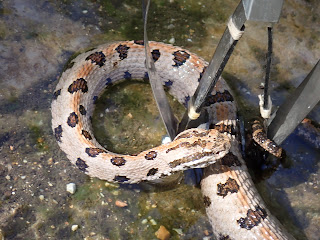.jpeg) I found these sets of small socket wrench heads on a shelf in our garage/workshop at Bull Mills. They had been undisturbed for over a year and now some were sealed off with a firm cap deposited by insects. The white material was chalk-like and firm but pulling each one out of the rubber holder revealed a variety of insect life both alive and now dead.
I found these sets of small socket wrench heads on a shelf in our garage/workshop at Bull Mills. They had been undisturbed for over a year and now some were sealed off with a firm cap deposited by insects. The white material was chalk-like and firm but pulling each one out of the rubber holder revealed a variety of insect life both alive and now dead.Removing a socket head from the rubber holder I was immediately faced with a larva coming out of its silken womb. I found a different one, darker and larger in another wrench head. They were very much alive and wanting to get away. I chased both around on our kitchen counter top, (I married the right woman!) filming it with a handheld microscope while trying to keep it in focus on the computer screen. You can see the chase in this video.
Next I opened several of the sealed chambers and found a variety of insects, all small. There were more larvae in their pupal cases, fighting for freedom. Other socket heads contained dead spiders with bodies less than a quarter inch long. I couldn't tell if they were all the same species.
.jpeg) The best preserved spider shown here had a little life left, shown by an occasional twitch of a leg. INaturalist couldn't venture a reasonable guess and it will remain a mystery.
The best preserved spider shown here had a little life left, shown by an occasional twitch of a leg. INaturalist couldn't venture a reasonable guess and it will remain a mystery.
Finally there was a totally different spider in the last socket head I opened. I lifted it onto my hand with a fine paint brush and its legs spread out in a natural pose. You can see its size in comparison to my finger print.
The point of this is that there is a lot more life out there than we can ever know. In the words of the philosopher Forest Gump in this clip, "Life is like a box of chocolates......you never know what you are going to get."
.jpeg)
.jpeg)
.jpeg)
.jpeg)










